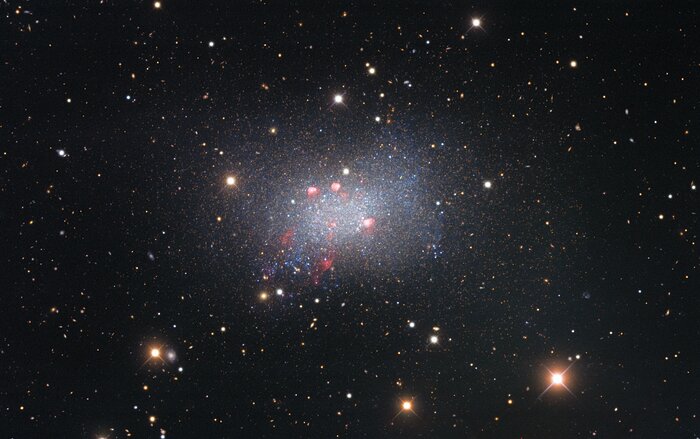
Galaxies in our universe come in a range of sizes, like the enormous IC 1101 which is 50 times the size of the Milky Way and is estimated to be up to 8 million light-years across — hence why it’s known as the Godzilla Galaxy. On the other end of the scale, you can find relatively tiny galaxies which can be as small as just 200 light-years across, like the teeny Segue 2.
But the fact a galaxy is tiny doesn’t mean it’s not of scientific interest, as this image of the dwarf galaxy Sextans B shows. Located 4.5 million light-years away and with a mass equivalent to 200 million times the mass of the sun, the dwarf galaxy is only a few thousand light-years in diameter. But despite this, it hosts a whole range of astronomical phenomena squeezed into its relatively diminutive size.
The most obvious features are the glowing red clouds near the center of the image which are composed of hydrogen. These are the birthplaces of stars, where the clouds clump together and eventually create a gravitational pull strong enough to form a new star.
The galaxy contains not only the nurseries of stars but also their graveyards, in the form of planetary nebulae. Sextans B is notable for being among the smallest galaxies to contain planetary nebulae, which are beautiful ring-like structures that are formed when a red giant star approaches the end of its life, though they aren’t visible in the image. As a star runs out of fuel, it throws off its outer layers which form elaborate structures in space.
The image was taken using the Nicholas U. Mayall 4-meter Telescope at Kitt Peak National Observatory, and as well as Sextans B it shows many other galaxies in the background which appear fuzzy, as well as stars in our galaxy which are located much closer to us and so shine brightly.
Editors' Recommendations
- See planets being born in new images from the Very Large Telescope
- Hubble spies baby stars being born amid chaos of interacting galaxies
- Hubble images a pair of galaxies caught in the process of merging
- Scientists investigate star formation in the famous Whirlpool Galaxy
- Hubble captures a formation of galaxies neatly lined up



